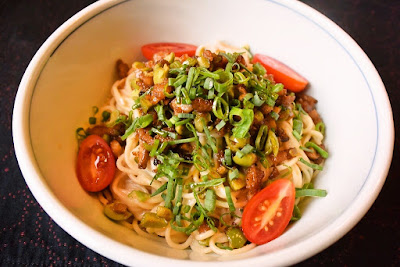Yummy dan dan noodles featuring okara-konnyaku bits and Chinese-flavored green olives. The numbing spiciness of hua jiao Sichuan peppercorns is intriguing in this dish. One of the big hits in our kitchen this year.
Use fewer noodles if adding more vegetables or other unflavored goodies, as the amount of sauce is on the low end below.
Use fewer noodles if adding more vegetables or other unflavored goodies, as the amount of sauce is on the low end below.
1/2 of recipe:
523 calories; 14.2 g protein; 16.2 g fat; 81.6 g carbohydrate; 75.6 g net carbs; 497 mg sodium (with lower sodium seasonings); 0.2 mg cholesterol; 6.0 g fiber
1/2 of recipe without noodles:
177 calories; 4.2 g protein; 14.2 g fat; 9.6 g carbohydrate; 5.6 g net carbs; 439 mg sodium (with lower sodium seasonings); 0.2 mg cholesterol; 4.0 g fiber
<Ingredients>
50 g okara-konnyaku no nikumiso-fu (sweet and salty fried ground soybean pulp yam cakes)
4 Chinese-flavored green olives (21 g with seeds in photo)
4 green onions (46 g in photo)
4 cherry/grape tomatoes (or 1 regular tomato)
2 tsp oil (to saute okara-konnyaku no nikumiso-fu & green olives; not in photo)
2-3 tsp hua jiao Sichuan peppercorns (optional)
For sauce
1 tsp oyster sauce
1 tsp shoyukoji soy sauce rice malt
2 tsp soy sauce
1 tbsp kurozu brown rice vinegar
2 tsp tahini
1 tbsp noodle cooking water (not in photo)
2 tsp rayu/la jiao you chili oil
<Directions>
1.
Halve grape tomatoes.
Slice green onions.
Chop green olives (discard seeds).
2.
Start boiling plenty of water to cook noodles. When water boils vigorously, put noodles, and boil until desired softness is achieved.
3.
In a small frying pan, heat oil, and fry hua jiao Sichuan peppercorns on low to medium low heat until fragrant.
Once fragrant, discard hua jiao peppercorns, add okara-konnyaku bits and green olives, and saute.
4.
Meanwhile, in a large prep bowl, combine all ingredients for sauce, other than rayu chili oil.
Add half to two-thirds of green onions (slices toward root ends), and mix well.
(In photo, hot water from the noodle pot is added -- its heat helps to incorporate all ingredients of the sauce.)
5.
When noodles are done, add to sauce, and mix well.
6.
Serve in individual bowls, and top with okara-konnyaku bits and green olives, tomatoes and remaining green onions.
Swirl over rayu chili oil immediately before eating.
Mix well, and enjoy.
<Notes>
- For a long time, tantan men meant (Japanese-style) Chinese noodles with a creamy reddish spicy soup and ground pork, and one without soup is relatively new. Yet the size of both styles is much larger than their Chinese originals as a result of adaptation.
- Sauce (mixed with rayu chili oil) is often directly put at the bottom of individual bowls, and noodles are then added along with toppings. Mixing sauce and noodles first and serving seems to work better as a sodium-savvy method (for even flavoring of noodles without using lots of sauce). Pouring rayu chili oil at the very end is to ensure a satisfying dish without using lots of sauce.
- Hua jiao Sichuan peppercorns is not needed if green olives retain sufficient flavor and aroma of peppercorns after the desalination process, or if using rayu chili oil infused with hua jiao.
- Make sure to boil noodles with plenty of water for lower sodium at the end if you are on a reduced sodium diet.
- Udon and hand-shaven noodles (with mizuna in photo at right) also pair well.
- Chinese-flavored green olives are a Chinese pickle substitute.
- For the above, the sodium figure is based on the assumption that 80% of sodium in noodles (292 mg sodium per bundle before cooking) is released into cooking water.
- All seasonings above are low sodium: Soy sauce (50% reduced-sodium Japanese brand; 470 mg sodium/tablespoon); shoyukoji soy sauce rice malt made with 50% reduced-sodium soy sauce; oyster sauce (Thai brand; 690 mg sodium/tablespoon; kurozu brown rice vinegar (Japanese brand; 0 mg sodium); and tahini (US brand; 0 mg sodium).












2 comments:
I love spicy noodles!
Your dan dan noodle recipe version is something I'd love to try, though I'd probably load it up too with plenty of shichimi togarashi for added heat. I also love how you used fresh tomato as a cooling component. Great job!
best wishes,
Jacklyn :)
Hi Jacklyn,
Thank you for the comment the other day. Dan dan noodles with soup was one of my regular lunch-out repertoire years ago in Tokyo, and this no-soup version is my first step to recreate the soup version I used to enjoy. Tomatoes are to help increase umami content; I feel I depend on tomatoes for that effect too much, but it does work! Very interesting about adding shichimi. I would reach for rayu spicy chili oil for heat and aroma, but I know some use shichimi to make rayu at home, I suppose it is possible.
Shichimi varies its taste and aroma by region and maker. Below is a short list of shichimi shops in Japan (all are widely available at grocery or department stores, souvenir shops in the region and across Japan as well as online; they also offer other spices). The first two from Kyoto are my favorites.
Kyoto
Shichimiya (http://www.shichimiya.co.jp/): Website in Japanese, English and Chinese
Ikkyuudo (http://www.kyo-yakumi-ikkyudo.co.jp/): Website in Japanese only; products widely available at shops in Kyoto/Osaka area as well as online
Nagano
Yawataya (https://www.yawataya.co.jp/): Website Japanese, English and Chinese
Tokyo
Yagenbori (http://yagenbori.jp/): Website Japanese,
Post a Comment